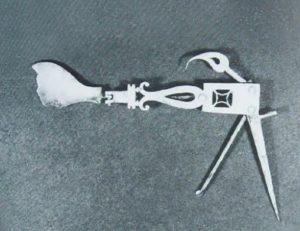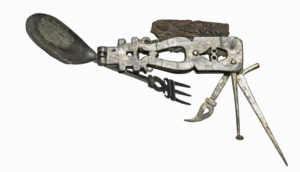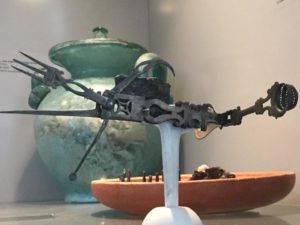Translated from French with ChatGPT (please notify us of errors)
A question for sharp minds: who invented the “Swiss Army knife”? Counterintuitively, the answer is not in the question, and Swiss expertise in this area was preceded. By Roman predecessors, no less.
But let’s first define what we’re talking about. What makes the so-called “Swiss” Roman knife special is its combination of multiple tools in a single pocket-sized object, at a minimum more than two, which can be useful as a travel dining set, but not exclusively.
While folding knives and combined utensils, with a spoon at one end and a fork at the other[1], have been relatively frequently unearthed by archaeologists, objects that compile more tools are very rare. We have found mention of four such items.
The first is said to be in the chest of a Swiss collector: no image, no information, let’s move on.

The Physician’s Possession
The second is certainly the least known of the visible specimens. It is on display at the Museum of Targovishte in Bulgaria. It is believed to have belonged to a Roman physician from the 3rd century AD, as it was found in a grave alongside surgical instruments. However, the medical use of the object is unlikely: it is hard to see how the spoon and fork, articulated on the same axis, would be used in such a context.

Food Scraper… or Ear Cleaner?
The specimen at the Fitzwilliam Museum in Cambridge[2] is very similar to the Bulgarian object. It also dates from the 3rd century and includes a knife blade. In addition, there is the spoon and fork on the same axis, along with three tools whose use is debated: a teardrop-shaped spatula, a punch, and a rod ending in a ball. For some, these are dining utensils for specific uses – extracting snail meat or scraping food. For others, these tools were intended for personal care. The small teardrop-shaped spatula would be an auriscalpium, or ear cleaner.

Seven Tools in Your Pocket
The fourth specimen is the most thoroughly documented[3]. It was discovered in 1917 by the archaeologist Pietro Barocelli in an intact tomb in the necropolis of Nervia of the ancient Albintimilium, now Ventimiglia, in Liguria. Dated to the 2nd century, it is on display at the city’s archaeological museum. At the time of discovery, the object’s uniqueness cast doubts on its authenticity. But, as we have seen, it is no longer unique.
It is also the most complete, as it features, in addition to the six tools found on other specimens, a unique utensil: a small sieve likely used to filter wine.
When the Swiss (re)inventor of the multi-blade pocket knife chose a name for his company in 1921[4], he combined two words: one modern – Inox – and the other Latin – Victoria – thus recalling that victorious inventiveness is originally Roman.
[1] See the 3rd-century specimen presented at the Metropolitan Museum of Art in New York: Silver spoon and fork
[2] Fitzwilliam Museum: Look, think, do: Roman Swiss Army Knife
[3] See Servizio di posate da viaggio sur TaccuiniGastrosofici.it
[4] The history of Victorinox.
October 2023, reproduction prohibited
Other articles in English from the Nunc est bibendum blog








